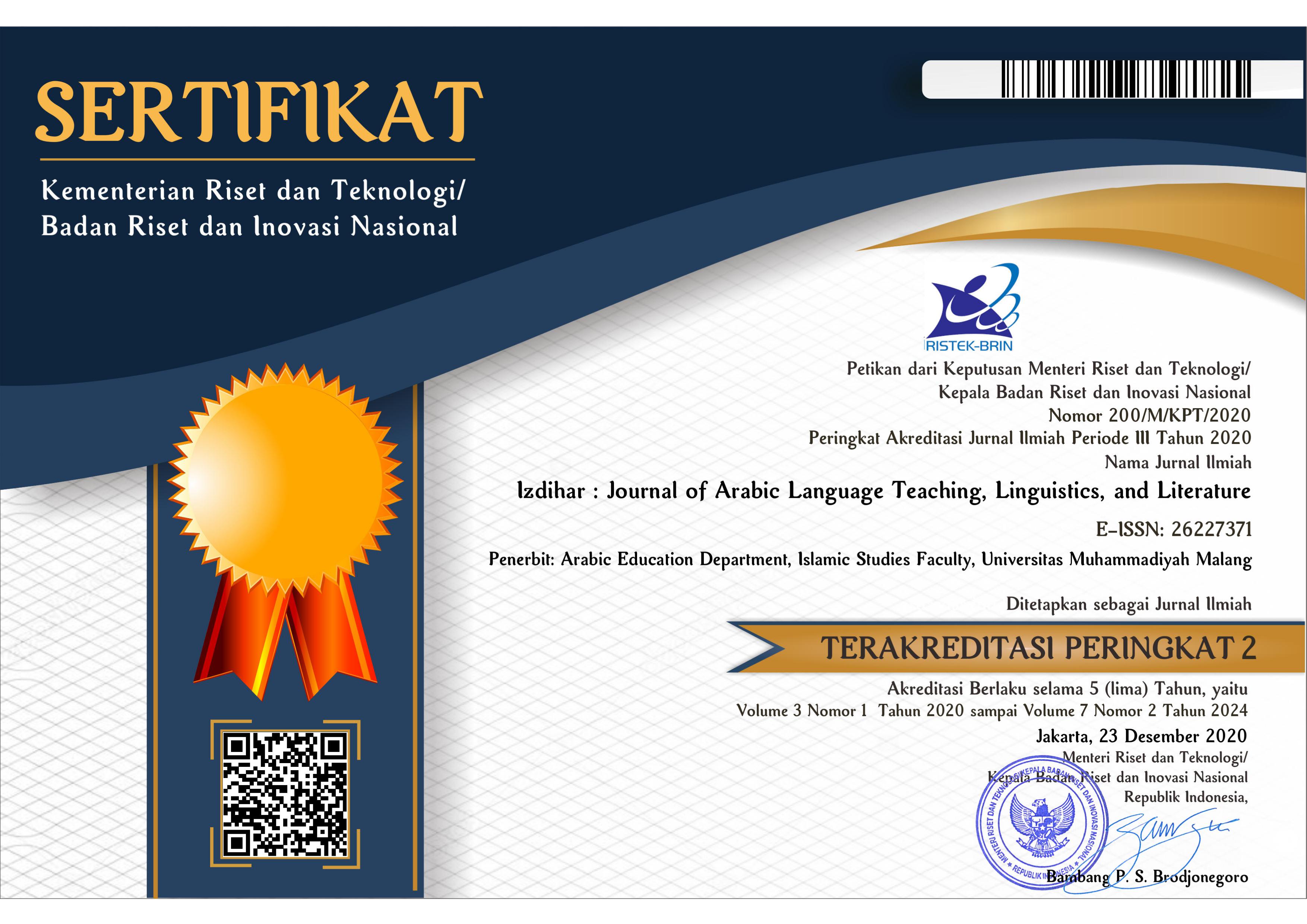Learning of Imla’ Using Flashcards on Writing Skill at Islamic Elementary School Level in Samarinda
DOI:
https://doi.org/10.22219/jiz.v3i1.11682Keywords:
Flashcard, Learning of Imla’, Writing SkillAbstract
There are some language skills, one of them is writing which has the steps of learning a foreign language. Writing skill has the most difficult skill. The use of instructional media has functions to facilitate teaching and learning activities, especially in Arabic learning of Imla’ material. The flashcard is used as a medium to facilitate teaching and learning activities of Imla’ for non-Arabic students. This research aimed to describe learning of Imla’ on Arabic writing skill and describe learning implementation of Imla’ on Arabic through flashcard at the level of elementary school at Elementary School level in Samarinda. The researcher used research design of qualitative descriptive by using the research instruments of observation, interview, and documentation. The research result obtained through the data sources from the principal, vice principal of curriculum, Arabic teachers and students. To analyze the data, the researcher used Miles and Huberman’s theory through three steps of data reduction, data display, and verification. The research results were that Arabic learning based on the writing skill on the elementary level included in category of Imla’ manqul which is aimed for students to be able to recognize, know, and rewrite letters of Hijaiyah by the rules of writing and letters written separated or connected with other letters. The students were also able to recognize the meaning of what they wrote through flashcard. The use of flashcard was helpful in the Arabic teaching process, because the students were easier in understanding the meaning of each vocabulary they wrote. The students did not feel saturated in teaching and learning proses, because flashcard can be used by the students as a form of game which they usually play such as picture card. Therefore, the Arabic writing skill on the elementary level will be easier to be learnt by the students.
Downloads
References
Al-Shbail, A. O., & Diab, M. A. B. (2018). Arabic Writing, Spelling Errors and Methods of Treatment. Journal of Language Teaching and Research, 9(5), 1026-1035. DOI: http://dx.doi.org/10.17507/jltr.0905.17
Alanazi, M. S. (2017). Use of Flashcards in Dealing with Reading and Writing Difficulties in SEN students. Multidisciplinary Journal of Educational Research, 7(1), 53-87. DOI: https://doi.org/10.17583/remie.2017.2211
Alowayidhi, W. H. (2014). Fa’iliyyah Istiratijiyyah Ta’lim al-Dzat al-Imla’iyyah li Iksabi Tilmidzat al-Shaff al-Tsani al-Ibtidai Maharat al-Imla’. Journal of Research Diyala Humanity, 2014(62), 558–587. https://www.iasj.net/iasj?func=article&aId=98122
Amir, F. A. (2000). Thuruq At-Tadris Al-Khas Bil Lugahah Al-Arabiyah wa Tarbiyatu Al-Islamiyah. Bairut: Darul Masyriqi.
An-Naqah, M., K. (1985). Ta’lim Al-Lughah Al-Arabiyah lillnathiqina billughah Ukhara. Makkah Mukaramah: Hudud Ath-Thobi’ wa Iadahtihi Mahfudzoh liljamiah Ummul Qura’.
Anggraini, R. D., Listyarini, I., & Huda, C. (2019). Keefektifan Model Picture And Picture Berbantu Media Flashcard Terhadap Keterampilan Menulis Karangan. International Journal of Elementary Education, 3(1), 35–40. DOI: http://dx.doi.org/10.23887/ijee.v3i1.17282
Angreany, F., & Saud, S. (2017). Keefektifan Media Pembelajaran Flashcard Dalam Keterampilan Menulis Karangan Sederhana Bahasa Jerman Siswa Kelas Xi Ipa Sma Negeri 9 Makassar. Eralingua: Jurnal Pendidikan Bahasa Asing Dan Sastra, 1(2), 138–146. DOI: https://doi.org/10.26858/eralingua.v1i2.4410
Annan, M., B. (2006). An-Nasyat Al-kitabi wa At-Ta’lim liltalmidzi At-thur Ats-sani min Khilali Maddati Al-Imla’. Wazirah At-Ta’lim Al-Aly wa Al-bahtsi Al-Aly Jamiah Al-Jadzairah (Ibnu Yushuf Bin Khadah).
Ar-Rasyidi, A. (2018). Ta’lim Maharah al-Kitabah Markaz Tarqiyah Al-lughah (Ahdafuha wa Musykilatuha wa Iqtirahat lilhuliha) fi Jamiah Al-islamiyah al-hukumiyah Jember. (2 C.E.). Al-Arabi: Journal of Teaching Arabic As A Foreign Language, 2(2), 134–149. DOI: http://journal2.um.ac.id/index.php/alarabi/article/view/7328
Arellano, R., Masykar, T., & Almulhim, A. (2019). The Rationale for A Proposal for English Language Education: The Experience of Developing A Curriculum to Teach English for Young Learners. Proceedings of 1st Aceh Global Conferenc (AGC 2018), 292, 179–185. DOI: https://doi.org/10.2991/agc-18.2019.27
Asy’ari, H., & Zainuddin, A. (2018). Ta’lim al-Lughah l-Arabiyah fi al-Ma'had Al-Salafi wa al-Ma'had al-Haditsi Namudzajan. Izdihar: Journal of Arabic Language Teaching, Linguistics, Literature, 1(2), 167–180. DOI: https://doi.org/10.22219/izdihar.v1i2.7298
Azab, S., Abd El Rahman, A., Ahmed, S., Farid, N., & Tamem, K. (2020). Factors Affecting Arabic Handwriting of a Sample of Adult Egyptian Twins. Ain Shams Journal of Forensic Medicine and Clinical Toxicology, 34 (1), 1–11. DOI: https://doi.org/10.21608/ajfm.2020.68006
Camplle, K., Chen, Y., Shenoy, S. & Cunningham, A. E. (2019). ‘Preschool children’s early writing: repeated measures reveal growing but variable trajectories’, Reading and Writing an Interdiciplinary Journal, 32, 939-961 DOI: https://doi.org/10.1007/s11145-018-9893-y
Chengyuan Jia & Khe Foon Timothy Hew. (2019). ‘Supporting lower-level processes in EFL listening: the effect on learners’ listening proficiency of a dictation program supported by a mobile instant messaging app, Computer Assisted Language Learning’, Computer Assisted Language Learning Journal, 2(2). DOI: https://doi.org/10.1080/09588221.2019.1671462
Chiang, H.-H. (2019). A Comparison Between Teacher-Led and Online Text-to-Speech Dictation for Students’ Vocabulary Performance. English Language Teaching, 12(3), 77–93. DOI: https://doi.org/10.5539/elt.v12n3p77
Fatoni, A. (2019). Arabic Learning for Academic Purposes. Izdihar : Journal of Arabic Language Teaching, Linguistics, and Literature, 2(2), 149-164. DOI: https://doi.org/10.22219/jiz.v2i2.10096
Gersmehl P. (2020) Symbolics, Syntactics, and Semantics: Teaching a Language of Maps. In: Brunn S., Kehrein R. (eds) Handbook of the Changing World Language Map. Springer, Cham. 249–274. DOI: https://doi.org/10.1007/978-3-030-02438-3_172
Handayani, T., & Suliswiyadi. (2019). Telaah Kritis Konten Kurikulum PAI Madrasah Ibtidaiyah di MI Ma’arif Bumiharjo Borobudur Magelang. Conference on Islamic Studies, 1(1), 157–174. http://jurnal.unissula.ac.id/index.php/cois/article/view/8009/3645
Hashemi, E. S., Aghagolzade, F., & Golfam, A. (2014). Phonological Adaptation of Arabic Loan Words in Persian : Consonants Eftekhar Sadat Hashemi. International Journal of Humanities and Social Science, 4(6), 225–236. http://www.ijhssnet.com/journals/Vol_4_No_6_1_April_2014/23.pdf
Hasrawati, & Ibrahim, H. (2018). Meningkatkan Kemampuan Mengenal Huruf Hijaiyah melalui Penerapan Metode Drill pada Kelompok B TK Islam Kemaraya Kendari. Jurnal Riset Golden Age PAUD UHO, 1(3), 27–32. DOI: http://dx.doi.org/10.36709/jrga.v1i1.2850
Indra, H. (2020). Pendidikan Madrasah dalam Membangun Akhlak Generasi Bangsa. Al-Afkar: Journal for Islamic Studies, 3(1), 89–102. https://al-afkar.com/index.php/Afkar_Journal/article/view/80
Jabir, A., H., J. (1989). Al-Imla' Ta'limuhu wa Ta'allumuhu wa 'Alaqah al-Akhtha' fih bi Mustawa al-Ta'lim. Bulletin of the Faculty of Humanities and Social Sciences: Qatar University. http://hdl.handle.net/10576/8893
Jannah, P. N. (2019). Problems of Teachers in The Teaching of Imla' for Students of the Ninth Semester in The Islamic Integrated Secondary School “Imam Syafi’i” East Java. Educan : Jurnal Pendidikan Islam, 3(2), 82-99. DOI: https://doi.org/10.21111/educan.v3i2.3581
Jauhari, Q. A. (2015). Pembelajaran Qowaid Al-Imlak Di Jurusan Pendidikan Bahasa Arab (PBA) UIN Maulana Malik Ibrahim Malang. Prosiding Konferensi Nasional Bahasa Arab (KONASBARA), 1(1), 318–324.
Jusoh, Z., & Abdullah, L. (2020). ESL Student Teachers Beliefs about Learning Arabic as a Foreign Language. International Journal of Asian Social Science, 10(1), 43–50. DOI: https://doi.org/10.18488/journal.1.2020.101.43.50
Komariah, N. (2016). Implementasi Kurikulum Tingkat Satuan Pendidikan (KTSP) Bahasa Arab Di MAN Tembilahan Indragiri Hilir Riau. Al-Afkar: Jurnal Keislaman & Peradaban, 2(2), 16-40. DOI: https://doi.org/10.28944/afkar.v2i2.92
Kuraedah, S. (2015). Aplikasi Maharah Kitabah dalam Pembelajaran Bahasa Arab. Al-Ta’dib: Jurnal Kajian Ilmu Pendidikan, IAIN Kendari, 8(2), 82–98. DOI: http://dx.doi.org/10.31332/atdb.v8i2.412
Lailan, E., & Lubis, S. (2016). Penerapan Metode Simulasi Untuk Meningkatkan Keterampilan. Al-Bayan: Jurnal Jurusan Pendidikan Bahasa Arab, 8(2), 33–52. DOI: https://doi.org/10.24042/albayan.v8i2.363
Lakshmi, B. S. (2019). Spelling Difficulties Faced by Learners of English as a Foreign Language. The Literary Herald An International Refereed English e-Journal, 5(1), 36–50. http://tlhjournal.com/uploads/products/5.dr.b.samrajya-lakshmi-article.pdf
Li, J., Tong, F. (2019). Multimedia-assisted self-learning materials: the benefits of E-flashcards for vocabulary learning in Chinese as a foreign language. Reading and Writing An Interdisciplinary Journal, 32, 1175–1195. DOI: https://doi.org/10.1007/s11145-018-9906-x
Li, L. (2020). Exploring the Effectiveness of a Reading-dictation Task in Promoting Chinese Learning as a Second Language. Higher Education Studies, 10(1), 100-108. DOI: https://doi.org/10.5539/hes.v10n1p100
Lindawati, N. P. (2018). Keefektifan Pengajaran Kosakata Bahasa Inggris Pada ِAnak Sekolah Dasar dengan Menggunakan Falsh Card. Jurnal Manajemen Pelayanan Hotel Akademi Komunitas Manajemen Perhotelan, 2(2), 59–65. DOI: http://dx.doi.org/10.37484/manajemen_pelayanan_hotel.v2i2.40
Maswani, M., & Susiawati, W. (2017). Kompetensi Profesional Guru Bahasa Arab Madrasah Aliyah Negeri (MAN) Di Jakarta. Arabiyat : Jurnal Pendidikan Bahasa Arab Dan Kebahasaaraban, 4(2), 185–203. DOI: https://doi.org/10.15408/a.v4i2.6290
Miles, M. B and Huberman, A. M.(1994). Qualitative Data Analysis. Sage Publications, London.
Muslim, B., & Marzuki, R. (2017). Istikhdam Wasilah al-Kalimat al-Mutaqathi'ah fi Tadris al-Imla' al-Istima'i li Tarqiyah Qudrah al-Thalabah 'ala Tarkib al-Jumal al-Mufidah bi Ma'had Dar al-Ihsan Aceh Besar. Lisanuna: Jurnal Ilmu Bahasa Arab Dan Pembelajarannya, 7(1), 1–32. DOI: http://dx.doi.org/10.22373/ls.v7i1.3778
Mustofa, D. (2019). Kemampuan Bahasa Arab dalam Pandangan Perilaku Keagamaan dan Kemampuan Menulis Arab ( Khat ). Lisanan Arabiyah: Jurnal Pendidikan Bahasa Arab, 3(1), 3–12. DOI: https://doi.org/10.32699/liar.v3i01.986
Nikmah, K. (2020). Interrogative Sentence: A Contrastive Study of Arabic and Indonesian. Izdihar : Journal of Arabic Language Teaching, Linguistics, and Literature, 2(3), 183–200. DOI: https://doi.org/10.22219/jiz.v2i3.10148
Omar, S., Nidhoimi, A., & Badrasawi, K. J. (2019). Challenges Facing Teachers of Arabic language (A2 Program) in Comoros Secondary Schools in Developing 21st Cuntury Learning Skills for Arabic Language Students. IJASOS: International E-Journal of Advances in Social Sciences, 5(15), 1659–1670. https://doi.org/10.18769/ijasos.592135
Özçakmak, H. (2019). Evaluation of Syrian Students’ Dictation Texts (A2 Level). World Journal of Education, 9(1), 179-187. DOI: https://doi.org/10.5430/wje.v9n1p179
Rahayu, T. & Santana, F. D. (2018). ‘Upaya Meningkatkan Keterampilan Menulis Awal Anak Usia Dini melalui Permainan Kartu Huruf pada Kelompok B TK Lima’, Tunas Siliwangi: Jurnal Program Studi Pendidikan Guru PAUD STKIP Siliwangi Bandung, 4.1, 10–24 DOI: https://doi.org/10.22460/ts.v4i1p10-24.1189
Ranjan, R., & Philominraj, A. (2020). Language Learning Strategies, Motivation and Gender in Foreign Language Context. Universal Journal of Educational Research, 8(2), 591–604. DOI: https://doi.org/10.13189/ujer.2020.080231
Rezania, V., Nuroh, E. Z., & Mariyati, L. I. (2020). Apprenticeship Sebagai Bagian Dari Cognitive Internship Capabilities as Part of Basic Teaching Skills for Elementary School. Pendagodia: Jurnal Pendidikan, 9(1), 43–52. DOI: https://doi.org/10.21070/pedagodia.v9i1.258
Ridwan. (2011). Al-Imla’ Nadzoriyatuhu wa Tatbiquhu. Malang: Universitas Islan Negeri Maulana Malik Ibrahim Malang.
Sebayang, A. A., & Nahar, S. (2017). Desain Pembelajaran Imla’ dalam Meningkatkan Kemampuan Munulis Tulisan Arab bagi Santri di Pondok Pesantren Ar-Raudlatul Hasanah Medan. Edu Riligia: Jurnal Ilmu Pendidikan Islam dan Keagamaan, 1(4), 573–588. https://scholar.google.com/citations?user=lvj2TL0AAAAJ&hl=id
Sholeh, S., Al-arous, M. (2015). Taqwim Al-maharah Al-Imlaiyah Inda Thulab Majiztir Ta’lim Al-lughoh Al-faransi wa Ta’limiha Kalughoh Ajnabiyah fi Al-ma’had Al-aly Lughat fi Jamiah Tasyirin. Tishreen University Journal for Research and Scientific Studies - Arts and Humanities Series, 4(37), 509–521. DOI: https://doi.org/th-mag@scs-net.org
Tuljannah, E., Rini, R., & Sofia, A. (2018). Hubungan Permainan Finger Painting dengan Kemampuan Menulis pada Anak Usia Dini. Jurnal Pendidikan Anak: FG-PAUD FKIP Universitas Lampung, 4(2). DOI: http://jurnal.fkip.unila.ac.id/index.php/PAUD/article/view/16480
Tavoosy, Y., & Jelveh, R. (2019). Language Teaching Strategies and Techniques Used to Support. Internasional Jornal of Learning and Teaching, 11(2), 77–88. DOI: https://doi.org/10.18844/ijlt.v11i2.3831
Ulum, F., & Mariah, E. (2017). Tadris al-Imla' bi al-'Arabiyyah li al-Nathiqin bi ghairiha, Musykilatuhu, wa Hululuhu. Arabi: Journal of Arabic Studies, 2(1), 93–104. DOI: https://doi.org/10.24865/ajas.v2i1.27
Wijaya, I. S., & Pimada, L. H. (2019). Ta’lim al-Imla’ bi Al-Wasait al-Muta’addidah li Tarqiyati Maharah al-Kitabah fi al-Lughah al-’Arabiyah. Jurnal Al Bayan: Jurnal Jurusan Pendidikan Bahasa Arab, 11(2), 194–213. DOI: https://doi.org/10.24042/albayan.v11i2.5266
Downloads
Published
How to Cite
Issue
Section
License
Copyright Notice
Authors who publish with this journal agree to the following terms:
- Authors retain copyright and grant the journal right of first publication with the work simultaneously licensed under a Creative Commons Attribution-ShareAlike 4.0 International License that allows others to share the work with an acknowledgment of the work's authorship and initial publication in this journal.
- Authors are able to enter into separate, additional contractual arrangements for the non-exclusive distribution of the journal's published version of the work (e.g., post it to an institutional repository or publish it in a book), with an acknowledgment of its initial publication in this journal.
- Authors are permitted and encouraged to post their work online (e.g., in institutional repositories or on their website) prior to and during the submission process, as it can lead to productive exchanges, as well as earlier and greater citation of published work (See The Effect of Open Access).
Copyright (c) 2019 Izdihar : Journal of Arabic Language Teaching, Linguistics, and Literature

This work is licensed under a Creative Commons Attribution-ShareAlike 4.0 International License.

















